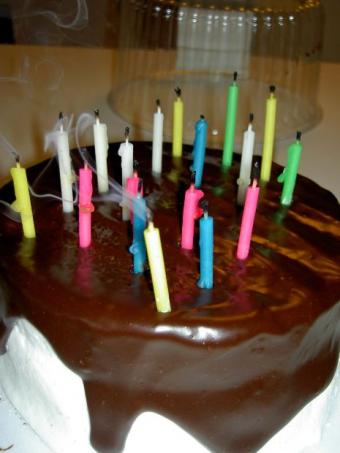
Learning how to make cake icing is one of the most useful investments of time for a decorator of any skill level. It's rare that a cake doesn't include frosting of some kind in its presentation, and there are so many icing types that it's useful to learn every kind to truly diversify your repertoire.
Make Five Different Kinds of Cake Icing
Basic recipes and techniques for how to make cake icing are easy to learn.
Royal Icing
Royal icing is one of the most delicate types of frosting. It has a thin consistency and works particularly well for piping very detailed designs, filigrees, or brush embroidery. Royal icing is also commonly used to top gingerbread cookies. It hardens quickly, and dried designs are very fragile.
To make a batch of royal icing, combine four cups of sifted powdered sugar, four egg whites, and water or flavored extract. Meringue powder can help the frosting set up well. The icing will be very thin and quickly forms a film on top, so keep it covered while you're working or whisk it regularly.
Buttercream

Buttercream is a versatile icing that partners well with almost any type of cake. It's the standby choice for birthday cakes, sheet cakes, and cupcakes, but it can also play an elegant role for weddings and other fancy events. Buttercream works better than other types of frosting for piping, and it's the frosting of choice for decorating many Wilton cakes.
To make enough standard buttercream to cover a two layer cake, combine one cup of softened butter, two tablespoons of water, and one teaspoon of vanilla extract. Gradually beat in four cups of sifted powdered sugar. Mix the ingredients with a powerful hand mixer or stand mixer until the frosting forms peaks and becomes fluffy.
Fondant

Most people don't like the taste or texture of fondant as much as they like buttercream, but it can't be beat for making precise designs and sleek, professional looking cakes. In its natural state, fondant is a bit like Play-Doh or modeling clay. Although many decorators prefer to roll it out into sheets with a rolling pin and drape the sheets over layer cakes, fondant is also ideal for making little figurines and cake toppers. If left out for several days, fondant designs will dry and harden.
You can make enough fondant to cover a two or three layer cake by combining unflavored gelatin, water, eight cups of sifted powdered sugar, two tablespoons of shortening, one teaspoon of vanilla or almond extract, one half cup of glucose, and one tablespoon of glycerin, the last two of which are available at cake decorating specialty stores. Check a specific recipe for combination instructions.
Ganache

In its purest form, ganache is simply melted chocolate with cream and sometimes butter. It has a fantastic taste and a thick, rich texture. While it is possible to pipe with ganache, its consistency makes it more difficult to work with than buttercream. Most decorators prefer to just pour warm ganache over an entire cake and wait for it to firm before serving the dessert.
For a basic ganache, combine nine ounces of melted chocolate with one cup of hot heavy cream. Beat the ingredients until the frosting is fluffy but still thin enough to be spreadable, or pour the warm frosting over your cake.
Meringue

Although it's more commonly used for pies than for cakes, meringue can lend a wild and creative look to any dessert. It has a unique, somewhat spongy texture if it's toasted and feels soft and sticky if not. Meringue frosting tastes great with tart lemon or lime cakes and coconut cakes.
Whip up a batch with two egg whites, one cup of sugar, water, cream of tartar, and vanilla extract. To toast the meringue peaks, use a kitchen torch.
The List Goes On
The frostings above aren't the only choices for topping cakes, but they are the best known and most popular. Other options, including fruit spreads, whipped cream, and cream cheese icings, combine very well with specific flavors and round out a complete arsenal of frosting knowledge. To be truly prepared for any cake occasion, learn to make them all.







